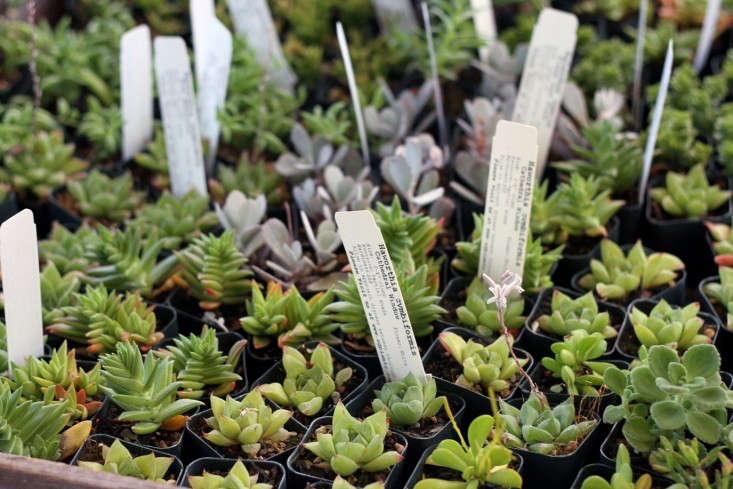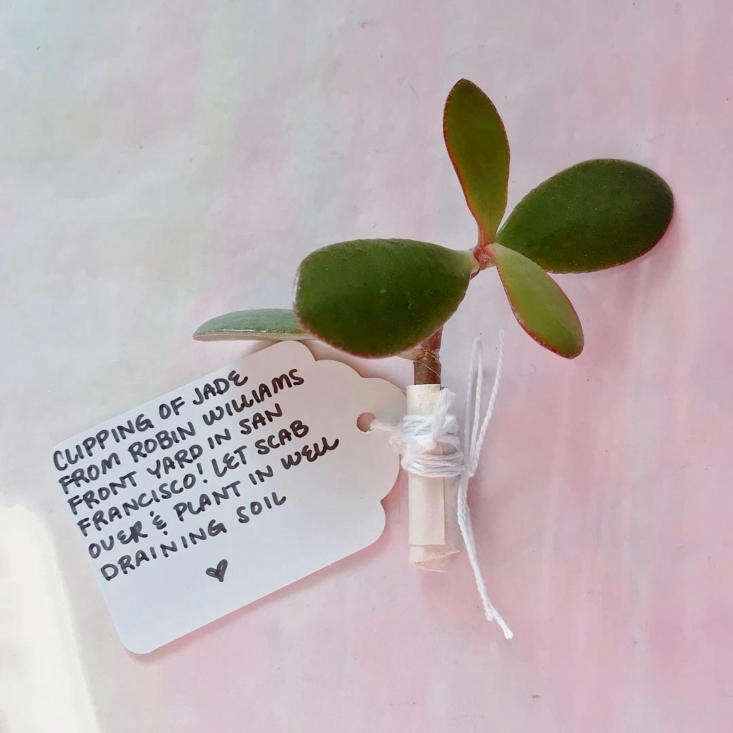You know those little plastic ID tags that come tucked into the pots or flats of plants you buy at a shop or nursery? The tags you usually toss as soon as you get home? Join the club: few gardeners pay those tags any mind; they already know there’s not much information to be gleaned from them.
To figure out just what those tags are good for, we talked with Susanne Kongoy, owner of GRDN, a plant and garden supplies store in Brooklyn’s Boerum Hill neighborhood. “Most people don’t really read the tags,” says Kongoy. “They just ask questions. And whatever’s recommended on a tag, in real life your care will be constantly changing. If it’s an indoor plant and you have the heat blasting all winter, your plant will dry out fast, so you’re going to have to water it more, or maybe mist it to make it happy.”
But the tags must serve some purpose? Well, it depends. Not all tags are created equal. Some tags use symbols instead of words, like a picture of a full sun or a sun with half its face blacked out. A tag might state if a plant is annual or perennial, how tall it gets, how wide it spreads, and maybe even the blooming period. Some companies, such as Glover Perennials, offer fuller information than others. “Glover sticks detailed labels on the pots that are amazing,” says Susanne. “Sometimes they even list which plants make good companions.”
But in other instances, “the most useful information on the tag is probably the plant’s Latin name,” says Kongoy. “That makes it easy to find the plant online, where you can really learn the basics.”
But meanwhile, let’s look at some common plant tag terms like “light,” “water,” and “USDA Zones,” and consider what they really mean.
(See more of Kongoy’s shop at GRDN in Brooklyn: Fall Colors in a Favorite Shop.)
Light

When a plant tag specifies a light requirement that ranges from “full sun” to “medium light” to “light to moderate shade,” what is the tag trying to tell you?
When a plant tag says…
Full sun: This means a plant needs from four to six hours of really good light every day (but “not ‘bright sun all day’,” says Susanne). A “full-sun” plant will thrive on a south-facing windowsill. Lavender, rosemary, and other Mediterranean plants will only do well in full sun.
Medium light: This is a plant that wants a lot of light, but not direct southern sun. Morning or late afternoon sun is fine, but don’t let it get burned by direct rays. This plant will do fine in a western-facing window.
Full to part sun: That means: Direct southern sun is OK, but the plant will also do well in medium light. The bottom line: Luckily for us, some plants are flexible.
Part sun: Kongoy suggests that four hours of sun a day would be fine—but it’s important to know how much light your home actually gets. “People always overestimate it,” she says. “If you’re really only getting morning light, we consider that low light for a plant.” Keep an eye on the plant to make sure it’s getting enough light—and perhaps relocate it to a sunnier spot if it’s not thriving.

When a plant tag says…
Part shade: This means that “part sun” is also OK, as long as it’s not direct sun. This plant will tolerate shade, and morning or evening sun is acceptable.
Full sun to part shade: Another easygoing plant!
Light to moderate shade: Some sunlight is OK, but not direct sun. (Need to bring some life to a darkish room? This plant could be the answer.)
Water

When a plant tag says…
Moderately moist soil, not wet: “People don’t understand that plants can have too much water,” says Kongoy. “After you water, let it go till it’s almost dry before watering again.” Check the top inch of soil in the pot to see if it’s moist. If it is, wait a few days, then water really well.
Keep moist: Water it well, and never let it get really dry. (If your garden is on a roof and/or in a hot climate, you’ll need to irrigate carefully to keep the soil from drying out.)
Prefers well-drained soil or requires excellent drainage: This is a drought-tolerant plant that prefers to be on the dryer side. “If there isn’t good drainage, the roots will stay wet and the plant will be unhappy,” says Kongoy.
The bottom line: Use a good potting mix in containers, never topsoil. Only use pots with drainage holes. If you’re planting outside, don’t put it in a clay soil that never drains.
Hardiness

When a plant tag says…
Avg. mod. home temp, 55–70°F.: The translation is that many houseplants are native to tropical zones like Florida, where they don’t have to contend with harsh winters. This temperature range is recommended for optimum growing conditions; not required. (If the mercury soars to 90 degrees Fahrenheit, there’s no need to run an air conditioner for your plants.)
Hardiness: Zone 8: This is a reference to the U.S. Department of Agriculture’s Plant Hardiness Zone Map. When you know which zone you live in, you’ll know which plants can survive the winter outdoors in your area. Find out your zone and remember it. A plant labeled Zone 8, for example, won’t winter over if you live anywhere north of North Carolina. (This isn’t relevant to houseplants, of course.)

Before investing in any new plant, make sure the conditions in your garden (or on your windowsill) will meet its requirements. Kongoy recommends asking the salesperson for care tips—and also looking up the plant online when you get it home to gather more details.

“You need to really get to know your plant and watch how it’s doing,” Kongoy says. “Check on it every three to four days. If it needs water, then water it; if it doesn’t, wait a couple of days and check again. The beauty of having a plant in your space is that it’s something to take care of. You can watch it grow, and take joy in that.”
Get to know your houseplants with tips from our curated guides to Houseplants 101, including Fiddle-Leaf Fig Tree: A Field Guide to Planting, Care & Design, Succulents & Cacti 101, and tropical plants such as Air Plants and Orchids.
Explore more in our Garden Design 101 plant care guides:









Have a Question or Comment About This Post?
Join the conversation